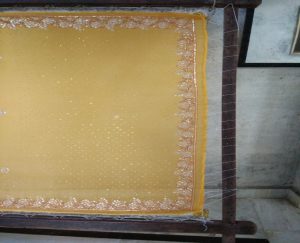 ‘I am a double M. A. without any job and help my mother in Zari-Zardosi work’ – that’s what Khustarbi a 23 years old had to say while talking about the condition of the Zari-Zardosi workers and their families. However, on the other hand her mother Farzana had a different story to tell – “It is the government which is not providing benefits to the educated members of the family.” She further added that now she sees no point in educating her children. With five daughters, two sons and husband residing outside the country, it becomes difficult for her to manage even the basic needs. This is the story of almost every household in the village Chandpur Jogiyan.
‘I am a double M. A. without any job and help my mother in Zari-Zardosi work’ – that’s what Khustarbi a 23 years old had to say while talking about the condition of the Zari-Zardosi workers and their families. However, on the other hand her mother Farzana had a different story to tell – “It is the government which is not providing benefits to the educated members of the family.” She further added that now she sees no point in educating her children. With five daughters, two sons and husband residing outside the country, it becomes difficult for her to manage even the basic needs. This is the story of almost every household in the village Chandpur Jogiyan.
Bareilly, which is considered as a hub for Zari-Zardosi work is into shackles. Workers hardly have any work now. Workers used to earn Rs 400-500/day earlier, now it has been reduced to Rs 250-200/day. When asked about the reason for such sharp decline in wages, GST unanimously emerged as a sole culprit. 18% of GST on the raw material and subsequently another 18% on the finished product is only a reflection of ill-conceived GST policy. It has led to drastic decrease in the number of orders of Zari-Zardosi products and consequently also eroded livelihood base of hundreds of artisan families.
There existed a huge demand for Zari-Zardosi products in three prominent areas Bareilly, Delhi, and Jaipur and bulk of orders came from these cities. These orders kept Zari-Zardosi workers engaged almost throughout the year but in post-GST era their livelihood activity has shrunk to mere 4-5 months. The export of Zari-Zardosi products has been banned and the orders and prices, both, have fallen substantially on the one hand, whereas delivery charges have risen very high.
Currently, 70% of the workers are dependent on labour work for day-to-day survival. They hardly have any savings. Earlier, when work was in plenty, women’ participation was also higher, but nowadays involvement of women in the work too has reduced due to less orders.
The government issued Zari card to workers engaged in this economic activity in 2009, under the ‘Zari Card Health Benefit Scheme’ having an upper limit up to Rs. 30,000. This was primarily a smart card linked with the card-holder’s bank account number, however after some time the smart cards failed to work.
 Mrs Shalu Saxsena, Bareilly, is a ray of hope for women involved in Zari-Zardosi work. She imparts training to women and also help them in getting orders for finished products. One of the workers, Ms Nikhat, said that work is fine and they get payment on per unit basis and they receive profit through Shalu Madam. Mrs Shalu Saxsena has also helped them in getting the Zari card. About 40 women are involved in this group. Their work is also being displayed at the exhibitions and members are free to sell the products and take orders independently.
Mrs Shalu Saxsena, Bareilly, is a ray of hope for women involved in Zari-Zardosi work. She imparts training to women and also help them in getting orders for finished products. One of the workers, Ms Nikhat, said that work is fine and they get payment on per unit basis and they receive profit through Shalu Madam. Mrs Shalu Saxsena has also helped them in getting the Zari card. About 40 women are involved in this group. Their work is also being displayed at the exhibitions and members are free to sell the products and take orders independently.
With such contrasting scenarios it would not be difficult to say that the condition of Zari-Zardosi workers and even this handicraft art itself is slowly dying as there is hardly any support on a sustainable basis to protect it.
Author – Shefali

Recent Comments